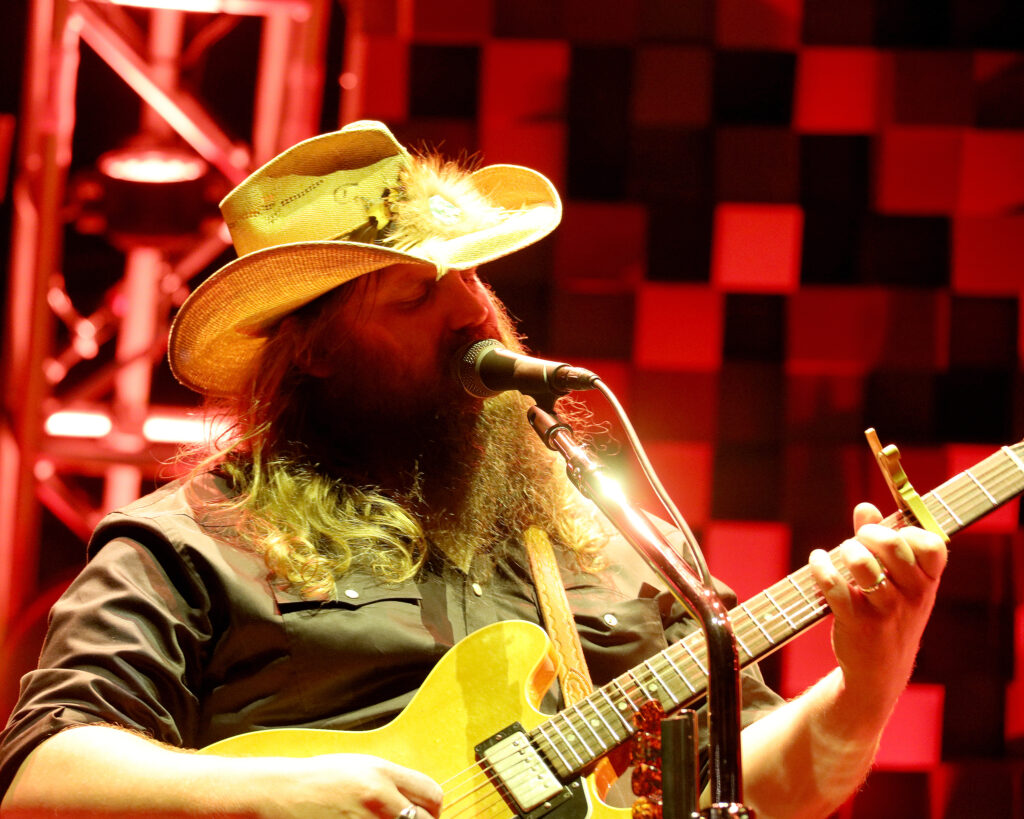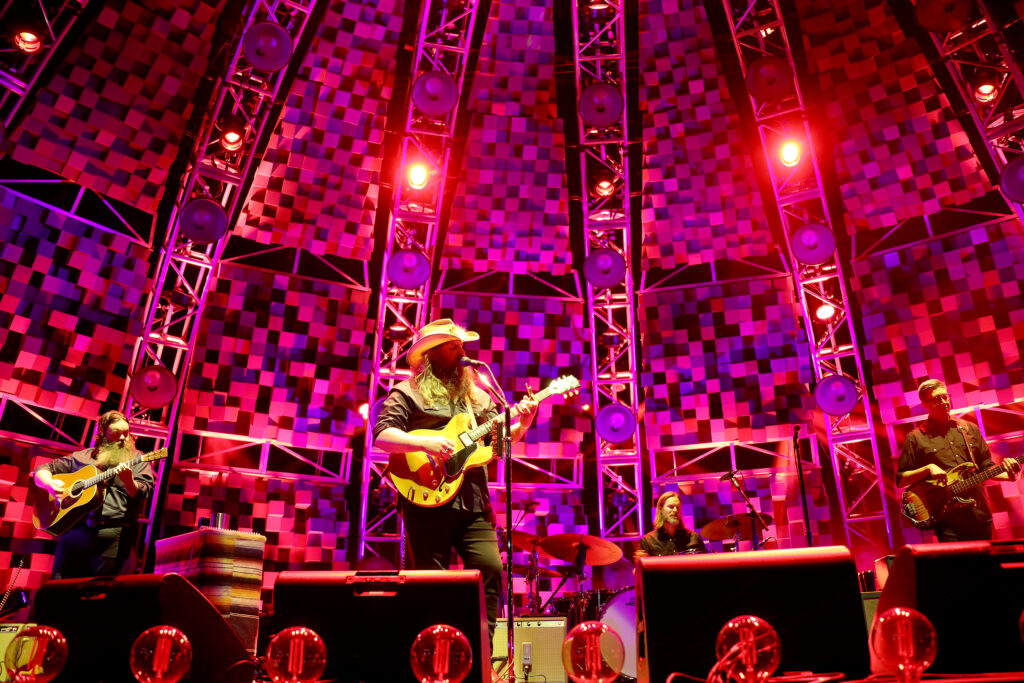A distinctive voice in country and blues music, Chris Stapleton has captivated audiences with his soul-stirring songs and impeccable guitar skills.
Known for his evocative lyrics and emotive performances, Stapleton’s talents transcend his vocal abilities. His relationship with the guitar forms a core part of his musical journey, offering a unique depth to his music that resonates with fans around the world.
Chris Stapleton performs selections of Garth Brooks’ work, including “Shameless” and “Rodeo” at the 2020 Library of Congress Gershwin Prize for Popular Song concert honoring Brooks at DAR Constitution Hall in Washington, D.C., March 4, 2020. Photo by Shawn Miller/Library of Congress. Note: Privacy and publicity rights for individuals depicted may apply.

Born in Lexington, Kentucky, in 1978, Chris Stapleton grew up in a household where music was always present. But it wasn’t just any music – his parents’ love for outlaw country and classic rock sowed the seeds of Stapleton’s musical tastes.
Yet, as important as these early influences were, it was the six-stringed instrument that would become Stapleton’s true companion and catapult him into the limelight. From his earliest performances to his multiple award-winning albums, the guitar has remained an integral part of Stapleton’s music.
Chris Stapleton’s Early Music Life
Chris Stapleton’s discovery of music and the guitar happened almost concurrently. Growing up in a small town in Kentucky, Stapleton was exposed to various musical genres from an early age.
Inspired by his parent’s record collection, featuring artists like Hank Williams and Aretha Franklin, he developed an eclectic taste in music.
The guitar entered Stapleton’s life when he was only 12 years old. With a second-hand acoustic guitar, he began to teach himself the basics.

He spent hours practicing chords and riffs, gradually developing his unique guitar style. His love for the guitar grew hand in hand with his passion for singing and songwriting, marking the start of his remarkable musical journey.
Stapleton’s early inspirations included various country, blues, and rock artists. The guitar techniques and styles he admired in these musicians greatly influenced his playing. From the raw bluesy sounds of B.B.
King to the southern rock vibes of Lynyrd Skynyrd, Stapleton absorbed and incorporated these diverse elements into his guitar playing.
As a self-taught guitarist, Stapleton’s growth as a musician was a process of continuous learning and exploration. He spent countless hours honing his guitar skills, learning new techniques, and experimenting with different sounds. His dedication to mastering the guitar was evident in his early performances, laying the foundation for the distinctive sound that fans have come to love.
Guitars Chris Stapleton Has Played
Stapleton’s choice of guitars throughout his career reflects his own evolution as a musician. One of the most iconic guitars associated with Stapleton is the Fender Telecaster.
Known for its bright, piercing tone and smooth playability, the Telecaster has been a staple in country music for decades. However, Stapleton’s style of playing, often characterized as a mix of country, blues, and southern rock, brings out a unique, grittier sound from this classic guitar.
The Fender Telecaster is not the only guitar that has defined Stapleton’s sound. A significant part of his collection is the Gibson J-45, an acoustic guitar known for its balanced tone and exceptional playability. Stapleton has often referred to this guitar as his workhorse for songwriting, appreciating its versatility and rich sound.
Stapleton’s collection extends beyond these two staples. Over the years, he has played a variety of other guitars, each with its unique attributes contributing to his distinct sound.
From Martin Acoustics to PRS electrics, the choice of guitar often reflects the mood and style of each song, underlining the depth and versatility of his musicianship.
Chris Stapleton’s Guitar Techniques
A great deal of Stapleton’s guitar mastery lies in his unique approach to the instrument. Stapleton’s picking style, characterized by his heavy use of fingerpicking, lends a distinctive rhythm to his music.
He often employs a thumb pick, a tool that allows for a powerful, clear sound, especially when playing the bass strings. This technique contributes significantly to the rhythmic drive of his songs, adding depth to his musical arrangements.
When it comes to guitar solos, Stapleton adopts a soulful, expressive approach. His solos often serve the song rather than showcasing technical prowess, conveying emotion with every note.
This sensitivity towards the song’s mood and narrative makes each of his solos a memorable part of the performance.

Stapleton’s guitar also plays a crucial role in his songwriting process. He often constructs songs around specific guitar parts, using the instrument not just for accompaniment, but as a vital tool for composition.
This deep connection between his guitar playing and songwriting underlines the central role of the guitar in Stapleton’s music.
Chris Stapleton’s Influence on Country and Blues Guitar Playing
Stapleton’s guitar playing has had a substantial impact on modern country and blues music. His unique blend of these genres, combined with his emotive guitar playing, has shaped a distinctive sound that many emerging artists aspire to emulate.
Stapleton’s music successfully merges the storytelling tradition of country music with the raw emotion of blues, expressed through his powerful guitar work. This unique fusion has redefined the boundaries of country and blues, inspiring a new generation of musicians.
Stapleton’s influence extends beyond his unique sound. His dedication to the craft of guitar playing and his continuous pursuit of authentic expression through his instrument inspire countless aspiring musicians.
His influence, both as a guitarist and a musician, continues to reverberate through the world of country and blues music.
Learning Guitar with Chris Stapleton’s Songs
For aspiring guitarists, Chris Stapleton’s music presents a rich resource for learning and practice. His songs encompass a range of difficulties, making them suitable for beginners just starting their guitar journey to advanced players seeking to refine their skills.
Among Stapleton’s vast repertoire, “Tennessee Whiskey” stands out as an excellent starting point for beginners. Its smooth chord progression and catchy riff offer a fun introduction to country blues guitar.
The song provides an opportunity to practice strumming techniques and familiarize oneself with the use of barre chords, fundamental skills for any guitar player.
“Parachute,” another fan-favorite, features a slightly more complex guitar part, involving alternate picking and a fast-paced strumming pattern. This track allows guitarists to practice their picking accuracy and speed while exploring the exciting world of country-rock guitar.
Numerous online resources offer comprehensive guides for learning Stapleton’s songs. Websites like Ultimate Guitar and Guitar World provide detailed tablature, chords, and even video lessons to help learners master these songs.
Chris Stapleton’s Legacy as a Guitarist
Chris Stapleton’s impact on the world of guitar music extends beyond his impressive catalog of hits. His deep understanding of the instrument, combined with his emotional depth as a songwriter, has cemented his status as a modern guitar legend.
Stapleton’s guitar prowess has earned him numerous awards and accolades, including multiple Grammy Awards for Best Country Solo Performance.
These recognitions not only highlight his vocal talents but also underscore the integral role of his guitar playing in shaping his award-winning sound.

But perhaps the most significant part of Stapleton’s guitar legacy is the “Stapleton Sound.” This term often refers to his unique blend of country, blues, and southern rock guitar, a sound characterized by emotive playing, intricate fingerpicking, and powerful solos.
This signature sound continues to influence a generation of guitarists and songwriters, leaving an indelible mark on the landscape of guitar music.
Frequently Asked Questions
Before wrapping up this in-depth look at Chris Stapleton’s guitar journey, let’s address some of the most frequently asked questions on this topic.
What kind of guitar does Chris Stapleton play?
Chris Stapleton often plays a Fender Telecaster for his electric guitar needs and a Gibson J-45 for acoustic performances. However, he has been known to use various other guitars throughout his career.
How did Chris Stapleton learn to play the guitar?
Chris Stapleton is primarily self-taught. He started playing the guitar at the age of 12, learning by practicing chords and riffs, and gradually developing his unique style.
What are some popular Chris Stapleton songs for beginner guitarists?
Tennessee Whiskey” is an excellent starting point for beginners due to its simple chord progression. “Parachute” is another popular choice, featuring a slightly more complex guitar part that allows guitarists to practice their picking accuracy and speed.
What is unique about Chris Stapleton’s guitar playing style?
Chris Stapleton’s guitar style is unique due to his blending of country, blues, and southern rock elements. He is known for his intricate fingerpicking, powerful guitar solos, and the emotive quality of his playing.
How has Chris Stapleton influenced guitar playing in country and blues music?
Chris Stapleton has significantly influenced these genres through his unique fusion of country and blues guitar playing. His emotive playing style and distinctive sound have inspired many emerging artists in these genres.
Summary
In conclusion, Chris Stapleton’s journey with the guitar is a testament to his immense talent, dedication, and love for music.
From his humble beginnings as a self-taught guitarist to his emergence as one of the most influential guitarists in modern country and blues music, Stapleton’s story inspires countless musicians around the world.
Whether through the soulful strumming of his Fender Telecaster or the powerful chords of his Gibson J-45, Chris Stapleton’s guitar continues to resonate with fans, leaving an indelible mark on the world of music.
